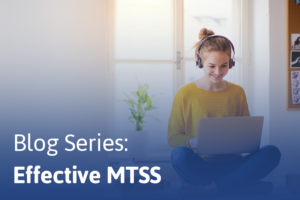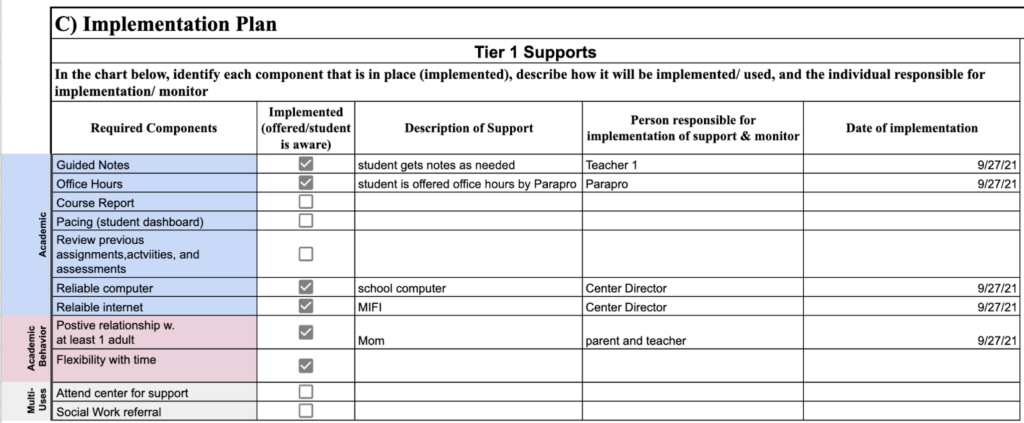BLOG SERIES: EFFECTIVE MTSS
Step 6: The Validation and Certification Process — Use of the GESP
Part 6 of virtual learning expert and Pulse user Chris Loiselle’s blog series
 Now that staff members had been introduced to MTSS and the process of creating a student support plan, the next step was to begin the use of a tool to document and track the support planning effort. The school we observed created a manual tool in Google Sheets called the General Education Support Plan (GESP). The choice was made to first apply this tool to all students with IEPs or 504 plans.
Now that staff members had been introduced to MTSS and the process of creating a student support plan, the next step was to begin the use of a tool to document and track the support planning effort. The school we observed created a manual tool in Google Sheets called the General Education Support Plan (GESP). The choice was made to first apply this tool to all students with IEPs or 504 plans.
The General Education Support Plan was designed to fill a gap in data collection and help train staff on effective support planning. Before the GESP, there was no systematic approach to collecting data on the implementation of Tier 1 (core instruction), Tier 2 (academic and academic behavior supports), or Tier 3 or accommodations required by the IEP of special education students or students with a 504 plan. The use of this data collection tool was used to promote intentional and meaningful discussion to better understand how a student may be supported, provide a guide for decision making, and accumulate detailed information about the fidelity and impact of their overall system of instruction (curriculum, supports, and student progress).
The GESP was composed of three sections:
Section A – The purpose of this section was to add pertinent information about the student to help guide the conversation to best determine the appropriate supports.
Section B – The goal of this section was to record notes about how well the tier 1 components were being implemented, the impact and appropriateness of any tier 2 supports, and the monitoring of any accommodations required by a student’s IEP or active 504 plan. Notes were required to be updated biweekly or more often as discussions are held about a student’s progress. Notes would revolve around the successful implementation of the tier 1 components. Once tier 1 has been fully implemented, notes would then move to better understand if Tier 2 supports were implemented, if they were beneficial to the student, and the frequency of student use. Then the meeting notes and discussion would move to the successful implementation of any tier 3 supports or accommodations outlined in a student’s IEP or active 504 plan. A sample of this section is below.

Section C – This section is where the actual implementation plan was briefly described, monitoring responsibility is assigned, and the date of the implementation tracked. To plan for successful implementation, it began with reviewing the successful implementation and fidelity of the tier 1 components listed. Any components not implemented would be a high priority and should be implemented before moving on to tier 2 or tier 3 implementation planning. Once all of the tier 1 components had been successfully implemented and a student continued to struggle then planning for successful implementation and fidelity of tier 2 academic supports would begin. A sample of this section is below.

As the Coaching staff began working through the GESP and implementing support plans, there was a consistent message from staff – it was too cumbersome and there was too much time involved with collecting and recording the data. In fact, the time being taken to track and record this information was taking away from the ability to support students. The good news was that the coaches had a solution already in hand – the Pulse Support Tool. The GESP process was merely being used to certify staff prior to moving to the automated solution. Once staff were informed of the transition plan, they worked diligently to become certified. Soon, entire school support teams were certified and enjoying the benefits of the Pulse Support Tool, described in our next, and final blog.
Next — Step 7: Automate and Simplify the MTSS Collection and Reporting Process Using Pulse

Since 2011 Chris Loiselle has worked as building administrator, CFO, and Chief Strategic Officer for Success Virtual Learning Centers and Berrien Springs Public Schools, where he is currently filling the Director of Quality Assurance role. While working at Success, Chris was instrumental in the development of the Pulse student support software. His passion is working in K-12 managing e-learning centers and building software to help improve virtual learning outcomes.
Chris first presented this 6-step process for effective MTSS at the Digital Learning Annual Conference in Atlanta, in February 2022.
His goal is to be able to help people prosper and succeed in today’s challenging educational environment.

